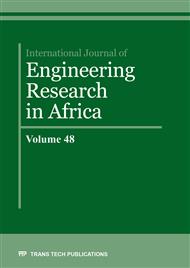[1]
L. Mebarki, M. Zidani, S. Mechachti, H. Farh, D. Miroud, Effect of Nickel Addition Study on the Mechanical Properties of the (Fe3C-Ni) Alloy Obtained by Solid Phase Compaction and Sintering, International Journal of Engineering Research in Africa, Vol.32, ( 2017) pp.18-24.
DOI: 10.4028/www.scientific.net/jera.32.18
Google Scholar
[2]
L. Baroura, A. Boukhobza, A. Derardja, K. Fedaoui, Study of Microstructure and Mechanical Properties of sintered Fe-Cu alloys, International, Journal of Engineering Research in Africa, 34 (2018) 5-12.
DOI: 10.4028/www.scientific.net/jera.34.5
Google Scholar
[3]
AP. Barbosa. Processing and mechanical properties of PM processed Fe– Cu–Co alloys. Mater Sci Forum; 5 91–593, (2008) 247–251.
DOI: 10.4028/www.scientific.net/msf.591-593.247
Google Scholar
[4]
K. Arar, L., Mansouri S., R. Benbouta, K. Fedaoui, Processing and Characterization of a Copper Based Binary Alloy Achieved by Solid Phase Compaction and Sintering, International Journal of Engineering Research in Africa, 38 (2018) 1-8.
DOI: 10.4028/www.scientific.net/jera.38.1
Google Scholar
[5]
B. Mais, Uses of copper and copper alloy powders, Metal (Germany), 53 (4) (1999)196-197.
Google Scholar
[6]
A. Molinari, Effect of copper powder type on liquid phase sintering of bronzes, Journal of metals ponder report, 57 1 (2002) 39.
DOI: 10.1016/s0026-0657(02)80064-9
Google Scholar
[7]
H. Mitsuhiro, N. Taiji, Further study on phase diagram of the iron-copper system, Calphad, 5, Issue 2, (1981) 105-108.
DOI: 10.1016/0364-5916(81)90036-5
Google Scholar
[8]
G. Mazzone and M. V. Antisari, Structural and Thermodynamic Factors of Suppressed Interdiffusion Kinetics in Multicomponent High-entropy Materials, Phys. Rev. B 54 (1996) 441–446.
Google Scholar
[9]
B. Mais, Uses of copper and copper alloy powders, Metal (Germany) 53 (1999) 196-197.
Google Scholar
[10]
R. M. German, Powder Metallurgy Science,, second edition, Metal Powder Industries Federation, Princeton, (1994) 292.
Google Scholar
[11]
D. Bouvard, "Métallurgie des poudres, Mécanique et Ingénierie des Matériaux, Hermes Lavoisier, (2002).
Google Scholar
[12]
D. Wilbert, W. Angel, Effect of copper on the mechanical properties of alloys formed by powder metallurgy, Materials and Design, 58 (2014) 12-18.
Google Scholar
[13]
L. Xu, C. Srinivasakannan, J. Peng, Sh. Guo, H. Xia, Study on characteristics of microwave melting of copper powder, Journal of Alloys and Compounds, 701 (2017) 236- 243.
DOI: 10.1016/j.jallcom.2017.01.097
Google Scholar
[14]
T. Nishizawa, K. Ishida, The Co−Cu (Cobalt-Copper) system. Journal of Phase Equilibria, 5, No. 2 (1984) 161–165.
Google Scholar
[15]
F. Keraghel, K. Loucif, M.P. Delplancke, Study of bronze porous alloy Cu-Sn worked out by metallurgy of the powders, Physics Procedia, 21 (2011) 152-158.
DOI: 10.1016/j.phpro.2011.10.023
Google Scholar
[16]
J. Bran, Elaboration et caractérisation de nanostructures Cu-Co: corrélation avec les propriétés magnétorésistives, thèse (2012).
Google Scholar


